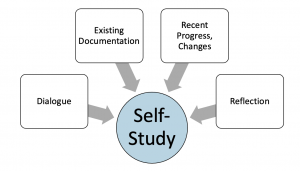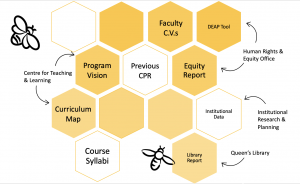1 Setting the Tone: Strategies for Preparing an Effective Self-Study
Introduction
In this section, you will find orienting information and suggested strategies for beginning a Cyclical Program Review (CPR) self-study as part of the Queen’s University Quality Assurance Process (QUQAP). This section intends to address the question that everyone has at the outset: How do we get started? It’s intended as an initial overview of how to set up for success, particularly in ensuring that your CPR is focused on the academic program, curricular strengths, and future opportunities for continuous improvement.
The Self-Study as a Process
Engaging in a self-study as part of the CPR, is first and foremost a process. The process results in a product: the self-study report itself, which becomes a resource for your reviewers during the site visit component. The process is intended to be faculty-led and collaborative. It is not something that one or two people from the department can engage in alone. Rather, the process requires collective conversation, input, and reflection.

As a process, the self-study has many inputs including:
- Dialogue: Conversations between members of the academic program, including faculty, staff, students, and the community
- Existing Documentation: such as past QUQAP documents (the program’s previous self-study, final implementation report, subsequent reports), existing documentation about the academic program, its curricular structure, and faculty complement.
- Recent Progress and Changes: recent conversations and materials that reflect current or future directions of the academic program (e.g. vision statements, plans for curricular monitoring or change)
- Reflection: equally important to dialogue is time for critical reflection. Those involved in producing the self-study will likely need some time to reflect, write, and provide feedback as the self-study process is engaged.
Many inputs come from collective conversation between members of the program itself: program leaders and administrators, faculty, and students. However, some inputs come from the various support units across campus. For example, the Human Rights and Equity Office provides an Equity Report and supports your group in making use of the DEAP Tool so that you not only have access to helpful data and information, you’re also supported by the Office as you use that information to inform parts of your self-study.

What is the best way to engage with support units to access and effectively utilize the available data/reports?
Each unit does their best to communicate what they do, what information/support they provide, and how this relates to your self-study. Because each unit serves different functions and needs, there is no single way for this engagement to happen. The best way for you to engage is to know who’s involvement you can expect. Here’s an overview:
- Human Rights and Equity Office: facilitate programs’ ongoing use of the Diversity and Equity Assessment and Planning (DEAP) Tool and produce an HREO-generated Equity Report of equity and diversity statistics
- Queen’s Library: produce a customized report of library services and resource usage statistics
- Institutional Research and Planning: support your access and interpretation of wide-ranging institutional data
- Centre for Teaching & Learning: facilitate faculty-driven activities such as program visioning, curriculum mapping, and supporting them to articulate elements of teaching strategies, assessments, or ‘progression of learning’
To ensure you’re connected with the right people, we advise directing your questions about support unit contacts to the QUQAP Team who can help address your inquiry.
The Self-Study Template as a Reference and Guide
A self-study template is provided to programs undergoing review by the QUQAP Team. It is provided in the form of an editable Word document (.docx), which outlines the various sections and sub-sections required of self-study report. The template is designed to match QUQAP policy, which are in-turn informed by the Ontario Universities Council on Quality Assurance, and their Quality Assurance (QA) Framework. It is recommended that you connect with the QUQAP Team for the most recent and up-to-date version of the self-study template.
Following the template ensures your self-study report covers all the required components based on the QA Framework and QUQAP policy. It is also intended to aid you in organizing the essential information that reviewers will need to conduct their site visit.
Frequently Asked Questions about the Self-Study Template
And… just how long do we have to do all this work?
If your program has already received a Notice of Assessment (NOA) from the QUQAP Team, that letter and accompanying documents will clarify a timeline of work for the unit. Typically, NOAs are issued one year before the final self-study report is due. This means that most programs are working on a one-year timeline to conduct their self-study and prepare the self-study report.
All programs at Queen’s are on an 7-year continuous quality assurance cycle, which the QUQAP Team organizes, monitors, and coordinates. Your CPR and self-study process is one part of this 7-year cycle. It is best to connect with the QUQAP Team to clarify outstanding questions about the timeline of work.
Strategies for Getting Started with a Self-Study
Form a Core Team
The CPR self-study process is necessarily a team effort. Consider who will be involved and in what ways. Many programs have found success by forming a core CPR team who will lead and coordinate the self-study efforts. This team may take on the bulk of the work and involve wider constituent groups for input, consultation, conversation, and/or review. An ideal core team consists of academic and administrative leaders (e.g. program director, under/grad chair, program manager etc.), representative instructors of the program, and administrative support staff. It may also involve students and community partners. The core team might then seek input from the wider instructional faculty, students, alumni, community partners, interdisciplinary partners, and academic support units.
Review QUQAP-Provided Guidance
The Notice of Assessment and CPR Timeline documents provided by the QUQAP team are an excellent place to start to better understanding the scope and timeline of program review. Attend a CPR Orientation session hosted by the QUQAP Team, and/or reach out to quqap@queensu.ca for one-on-one guidance.
Familiarize or Reacquaint with Existing Program Materials
The goal of quality assurance is for the academic program to be in a continual state of evaluation, improvement, and development. Consider the program’s history and its current state. What materials already exist that reflect the program’s history, origins, and progression over time?
If the program has previously undergone a CPR: The previous CPR will have generated a great deal of materials to review and reference as you prepare for the upcoming CPR. Recommendations, actions, and changes arising from the program’s last CPR (6-8 years ago) should be known. Ongoing program evaluation and data collection (e.g. alumni surveys) might also be an ongoing activity. As a starting point, it can be helpful to begin by checking in with and reacquainting oneself with existing and ongoing documentation, for example, reviewing the previous CPR self-study, review team report, internal responses, and Final Assessment Report (FAR). It is also helpful to review documents that capture changes made to the program since the last CPR (e.g. major modifications), and to begin curating the ongoing program evaluation components that might inform the CPR process.
If this is the program’s first CPR: If this is the first time a program has undergone cyclical review, consider reviewing materials such as the New Program Proposal. The Program Proposal likely includes elements such as program learning outcomes, and a curriculum design overview, that can be a useful starting point as you head into the CPR. Also consider, what types of program evaluation methods were introduced at the program’s inception? For example, did the program build in exit surveys with graduating students as part of an initial program evaluation plan?
Clarify the Programs Under Review
It’s likely that many programs are under review at the same time. Clarify which programs are to be reviewed. This will be an important to clarify before going forward (such Section 5 of the self-study template, where you will detail curricular structure of the academic programs under review). Different programs ought to have different learning outcomes and curricular pathways (e.g. different course requirements). These nuances are to be described and clarified in Section 5. The sooner your group has a sense of precisely which programs are under review as part of the unit/department’s self-study, the better you can set up for success in distinguishing between programs.
Clarify your Own Timeline of Work
The QUQAP Team provides a CPR Timeline to programs under review as a guide. Customize this timeline for your own team by clarifying key milestones, and defining your own team’s scope of work within the parameters of the review. Effective teams incorporate elements of project management into their workflow:
- What are the goals and constraints?
- Who will take leadership on which components? Who will be assigned with particular aspects of the work?
- How can the process be broken down into smaller tasks with checkpoints and deadlines?
Setting the Tone Summary
Again, this page is intended as an initial overview offering strategies for effectively launching into the CPR Process. There may be other burning questions on your mind, and the QUQAP Guidance and Templates may provide some of these answers.
Icon Attributions
FAQ by Setyo Ari Wibowo from NounProject.com

